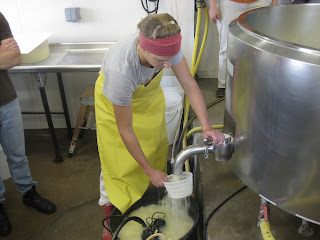
After a brief introduction and history of the farm by farm owner Angela Miller, Peter arrived with the milk which he had picked up at Jersey Girls, a partner farm with Jersey cows. After filling the vat, we made a
Pawlet, an Italian style toma cheese. Peter took us through all basics steps of making the cheese. He talked extensively about starter cultures. He explained the flocculation technique he uses to determine when to cut the curd. After that he took us through the cooking stage, the draining stage and finally the hooping of the curds into the molds. All basic steps of cheesemaking were very well explained and there was plenty of time for questions and discussion.
After a wonderful lunch of garden fresh salads prepared by Angela and, of course, cheese, we went into the caves. We washed and brushed rinds and talked about cave design.
After a good night sleep at the farm we were fresh the next morning to put the cheeses we made into the brine. Before proceeding with this, Peter took the Ph of the cheeses. He took this opportunity to explain the use of Ph as a target in various stages of the making process. Finally it was time to brine the cheeses at which time brine and brine recipes were discussed. After this it was time for cleaning the tools and equipment, a major part of cheesemaking.
After another terrific lunch, it was time for some theoretic discussion of affinage. Using overhead projection, Peter explained all stages of affinage and talked extensively about the different rind developments and different bacteria and other micro organisms and their influence on various types of cheeses.
Driving home, I felt filled with a plethora of new information and can't wait to put it into practice.


























